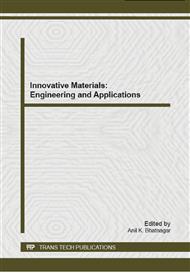[1]
W. Zhang, Y. Chai, R. Yuan, J. Han, S. Chen, Deposited gold nanocrystals enhanced porous PTCA-Cys layer for simultaneous detection of ascorbic acid, dopamine and uric acid, Sens. Actuators B 183 (2013) 157–162.
DOI: 10.1016/j.snb.2013.03.122
Google Scholar
[2]
X. Zuo, H. Zhang, N. Li, An electrochemical biosensor for determination of ascorbic acid by cobalt (II) phthalocyanine–multi-walled carbon nanotubes modified glassy carbon electrode, Sens. Actuators B 161 (2012) 1074–1079.
DOI: 10.1016/j.snb.2011.12.013
Google Scholar
[3]
V.L. da Silva, M.R.F. Cerqueira, D. Lowinsohn, M.A.C. Matos, R.C. Matos, Amperometric detection of ascorbic acid in honey using ascorbate oxidase immobilised on amberlite IRA-743, Food Chem. 133 (2012) 1050–1054.
DOI: 10.1016/j.foodchem.2012.01.066
Google Scholar
[4]
W. Zhang, Y. Chai, R. Yuan, S. Chen, J. Han, D. Yuan, Facile synthesis of graphene hybrid tube-like structure for simultaneous detection of ascorbic acid, dopamine, uric acid and tryptophan, Anal. Chim. Acta 756 (2012) 7–12.
DOI: 10.1016/j.aca.2012.10.044
Google Scholar
[5]
K. Deng, J. Zhou, X. Li, Noncovalent nanohybrid of cobalt tetraphenylporphyrin with graphene for simultaneous detection of ascorbic acid, dopamine, and uric acid, Electrochim. Acta 114 (2013) 341–346.
DOI: 10.1016/j.electacta.2013.09.164
Google Scholar
[6]
W. Bian, J. Ma, W. Guo, D. Lu, M. Fan, Y. Wei, Y. Li, S. Shuang, M.M.F. Choi, Phosphorescence detection of L-ascorbic acid with surface-attached N-acetyl-L-cysteine and L-cysteine Mn doped ZnS quantum dots, Talanta 116 (2013) 794–800.
DOI: 10.1016/j.talanta.2013.07.076
Google Scholar
[7]
N. Malashikhina, V. Pavlov, DNA-decorated nanoparticles as nanosensors for rapid detection of ascorbic acid, Biosens. Bioelectron. 33 (2012) 241–246.
DOI: 10.1016/j.bios.2012.01.011
Google Scholar
[8]
J.S. Graça, R.F. de Oliveira, M.L. de Moraes, M. Ferreira, Amperometric glucose biosensor based on layer-by-layer films of microperoxidase-11 and liposome-encapsulated glucose oxidase, Bioelectrochemistry 96 (2014) 37–42.
DOI: 10.1016/j.bioelechem.2014.01.001
Google Scholar
[9]
M.G. Traber, J.F. Stevens, Vitamins C and E: Beneficial effects from a mechanistic perspective, Free Radic. Biol. Med. 51 (2011) 1000–1013.
Google Scholar
[10]
I.G. Casella, M. Contursi, Pulsed electrodeposition of nickel/palladium globular particles from an alkaline gluconate bath. An electrochemical, XPS and SEM investigation, J. Electroanal. Chem. 692 (2013) 80–86.
DOI: 10.1016/j.jelechem.2013.01.015
Google Scholar
[11]
C. Tsukada, S. Ogawa, H. Niwa, T. Nomoto, G. Kutluk, H. Namatame, M. Taniguchi, S. Yagi, Morphological and spectroscopic studies on enlargement of Pd nanoparticle in L-cysteine aqueous solution by AFM and XPS, Appl. Surf. Sci. 267 (2013) 48–52.
DOI: 10.1016/j.apsusc.2012.05.123
Google Scholar
[12]
Z.H. Sheng, X.Q. Zheng, J.Y. Xu, W.J. Bao, F.B. Wang, X.H. Xia, Electrochemical sensor based on nitrogen doped graphene: Simultaneous determination of ascorbic acid, dopamine and uric acid, Biosens. Bioelectron. 34 (2012) 125–131.
DOI: 10.1016/j.bios.2012.01.030
Google Scholar


